Lighthouses are some of America’s earliest constructed buildings, dotting up across the coastline from North Carolina up to Delaware to help sailors navigate difficult passages. Lighthouses themselves are an ancient tradition, one that speaks to our consistent need for guidance in the dark. As such, many lighthouses become travel destinations in and of themselves, and we’ve compiled a list of the 5 most beautiful lighthouses on the East Coast.
Read on to discover where to plan your next lighthouse visit!

Cape Neddick Lighthouse
The Cape Neddick Lighthouse is one of America’s most photographed lighthouses, set against the picturesque backdrop of the rocky shores of the Atlantic Ocean. Every year an estimated 500,000 tourists flock to York Beach, Maine to catch a glimpse of this famous lighthouse, positioned roughly 100 yards away from Cape Neddick Point at Long Sands Beach.
The lighthouse cannot be visited by the public, but nearby Sohier Park has a telescope for viewing purposes and a themed gift shop nearby for those looking to come away with a souvenir. A digital photograph of the Cape Neddick Lighthouse was even carried into space on the Voyager II space probe as part of a package created to teach potential alien life forms about human culture.
The Cape Neddick Lighthouse is 41 feet tall and was commissioned in 1874 when the townspeople of York, Maine made an appeal to the United States government for a lighthouse to keep their sailors safe at night. America’s 19th president Rutherford B. Hayes proportioned $15,000 to support the construction of the Cape Neddick Lighthouse, which was completed within 5 years and opened on July 1st, 1879.
On April 16th, 1985, the lighthouse was officially made a part of the National Register of Historic Places. It is still in use today, although it was automated when the United States Coast Guard relinquished their responsibility of upkeep in 1987. Two years later York was given a 30-year lease on the lighthouse, and it is currently owned and maintained in partnership with the United States Government.
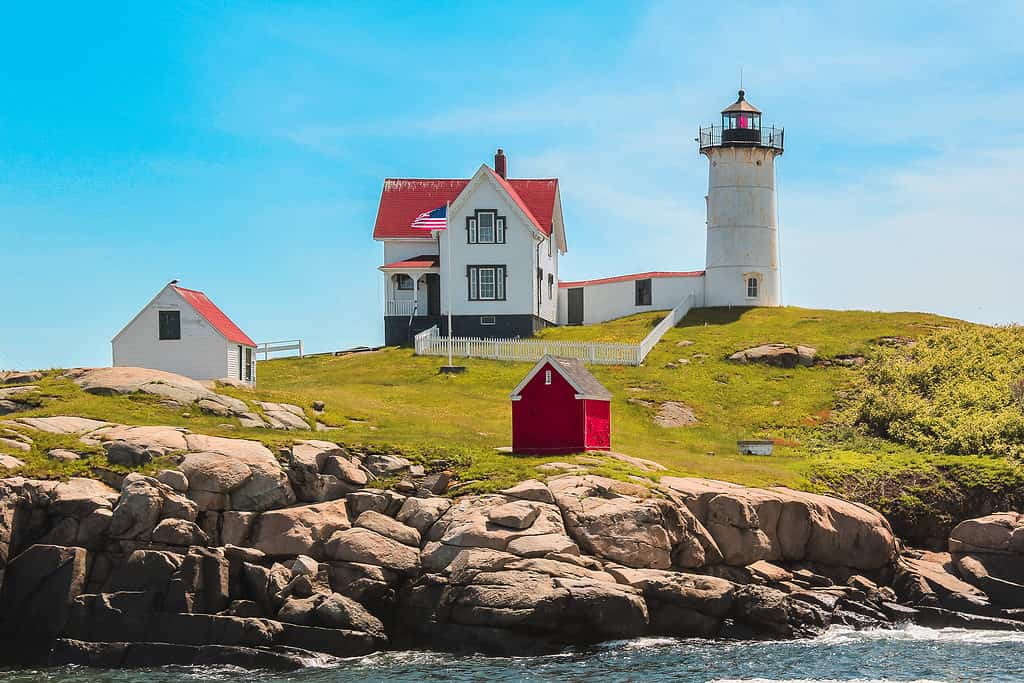
An estimated 500,000 tourists visit York Beach, Maine each year to catch a glimpse of the Cape Neddick Lighthouse.
©FordPics.com/Shutterstock.com
Gay Head Light
The Gay Head Light is a historic lighthouse and the first to be built on Martha’s Vineyard, a famous island just south of Cape Cod off the coast of Massachusetts. The lighthouse itself was constructed on the west end of Lighthouse Road, and it sits amongst the famously kaleidoscopic clay cliffs of Aquinnah, Massachusetts.
As the United States government began to form itself for the first time in 1789, one of its first priorities was to establish the construction and/or maintenance of America’s lighthouses. This issue was often overseen by top-level officials, including the President himself, as these structures played an important part in facilitating the kind of trade and transport that benefits a still-growing nation.
In 1796 Peleg Coffin – the State Senator from Massachusetts – formalized a request for a lighthouse to be built on the Gay Head Cliffs in order to help boats navigate the “Devil’s Bridge” – a series of underwater rocks off the coast. President John Adams certified the $5,750 construction of the lighthouse in 1798, and the Gay Head Light was completed by the following year, originally made almost entirely of wood.
The lighthouse had to be displaced 75 feet back from the cliffside in 1844, as the inevitable effects of erosion took their toll on the natural landscape. Nearly a decade later, in 1856, the original wooden structure was torn down and rebuilt with brownstone and brick.
The newly fortified Gay Head Light became one of the first lighthouses in America to have a Fresnel lens installed. Fresnel lenses are famous worldwide for revolutionizing the functionality of lighthouses, as they require less material to be built while still achieving their purpose of illumination and projection.
The Gay Head Light is also famous for being the only lighthouse in the United States to have employed Native American lighthouse keepers. Many people in the surrounding area were members of the Wampanoag Indian tribe, and their descendants still populate the town of Aquinnah today.
In 1987 it was entered into the National Register of Historic Places and today is owned by Aquinnah, thanks to the success of the “Save the Gay Head Lighthouse” campaign. It is maintained by the Martha’s Vineyard Museum in conjunction with the Massachusetts Historical Commission and the National Park Service, where it is currently a museum that attracts visitors year-round.
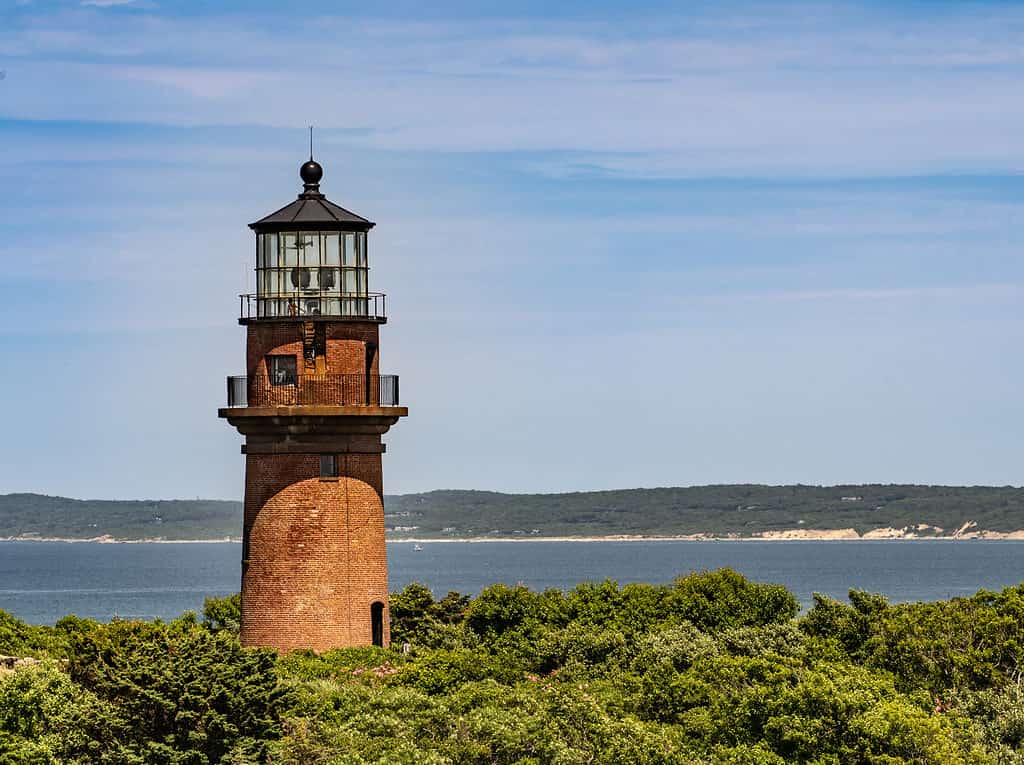
Gay Head Light is a historic lighthouse built on the Gay Head Cliffs on Martha’s Vineyard.
©iStock.com/arlutz73
Montauk Lighthouse
The Montauk Lighthouse is not just Long Island’s first lighthouse, but also the oldest lighthouse in the state of New York. It is located on the far eastern side of Long Island.
President George Washington and the United States Congress approved its construction in 1794 and provided $255.12 in funds in order to acquire the land. It was finished in 1796 at a site used by the British Royal Navy to light signal bonfires to guide their ships fighting in the American Revolution.
John McComb Jr, a well-known architect in his time, was charged with building the Montauk Lighthouse on a budget of $22,300. Standing at a towering 110 feet tall, the Montauk Lighthouse has helped steer steam-engine ships, sailboats, whaling vessels, fishing boats, and even submarines through the dangerous waters below.
The United States Army and Navy assumed control of the Montauk Lighthouse from 1941 to 1945, for the duration of the Second World War. The plan was to utilize the tower as part of an Eastern Coast Defense Shield in the case of invasion by German forces. When the war ended, ownership of the lighthouse was transferred to the United States Coast Guard.
In 1987 the Coast Guard replaced the tower’s Fresnel lens with an automated beacon. Prior to that, the house attached to the tower was regularly the residence for a number of lighthouse keepers and their family members and/or assistants.
There was a small period of time in the late 1960s when the Montauk Lighthouse was in danger of pre-emptive demolition. There was concern that erosion, now nearing the lighthouse at a distance of merely 46 feet, would take its toll in the coming years. A local protest was organized and over 3,000 people eventually convinced the Coast Guard to keep this historical lighthouse in place. Volunteers help terrace the cliffside in order to combat the encroaching erosion and after two decades of work, they succeeded in warding it off completely.
The Montauk Lighthouse is currently under the ownership of the Montauk Historical Society, which turned the tower and residence into a museum and built a visitor center for the number of tourists it draws every year.
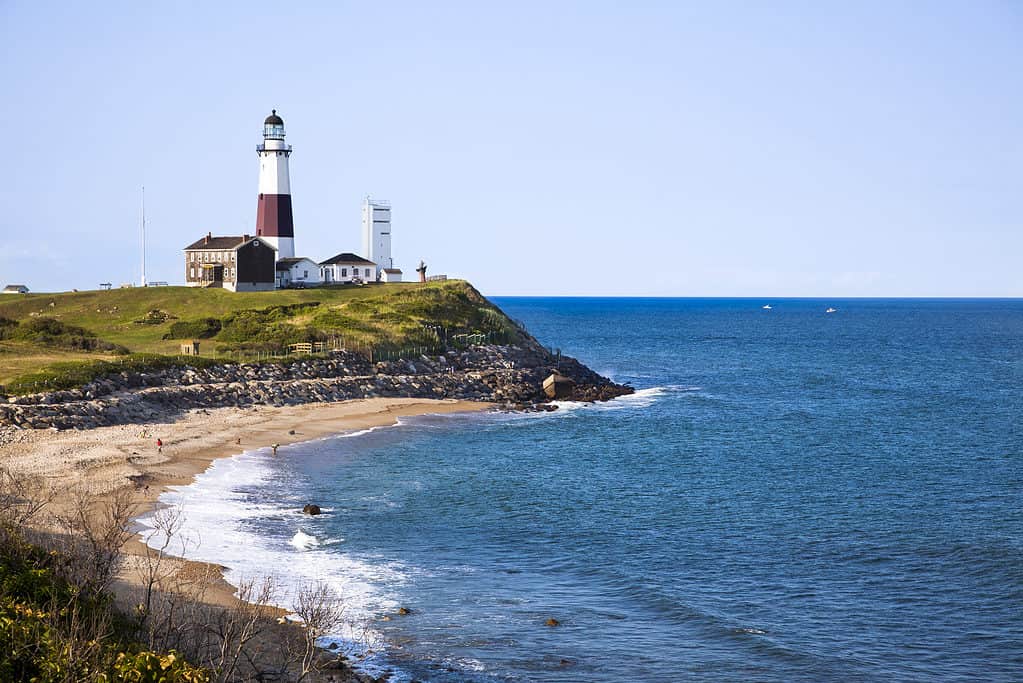
Montauk Lighthouse is Long Island’s first and oldest lighthouse in the state of New York.
©iStock.com/MikeRega
Fire Island Lighthouse
The Fire Island Lighthouse is a historic lighthouse that was often the first thing immigrants to the United States saw as they pulled into New York Harbor. It is the tallest lighthouse on Long Island, which currently houses about 20 towers in various conditions.
Built in 1826, it was originally only 74 feet tall and made of split stone. This miscalculation in height meant that the lighthouse wasn’t very helpful to ships navigating through the night, which necessitated its removal and rebuilding in 1857.
The United States Congress proportioned $40,000 in order to raise a new structure that stood 168 feet tall – this time built with brick and painted yellow. This newer version of the lighthouse was in operation by November of 1858. In August of 1891, the lighthouse was painted with its now iconic pattern (known as “daymarks”) of shifting black and white stripes.
Today, the Fire Island Lighthouse is sought out for its 360-degree view of New York Harbor – certainly, worth the 182 steps, it takes to get to the top! There $10 tours are available for visitors, with all funds going to the Fire Island Lighthouse Preservation Society who help maintain the lighthouse in cooperation with the National Park Service. The tower still helps private ships navigate and is officially run by the United States Coast Guard.
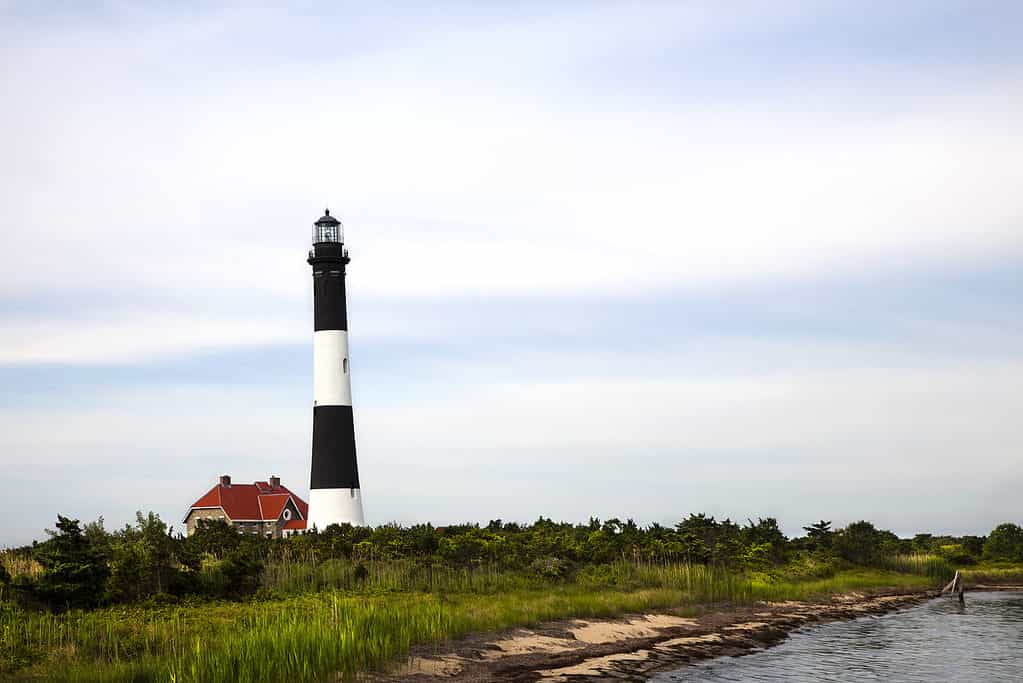
Fire Island Lighthouse was first built in 1826 but at only 74 feet tall it needed to be torn down and rebuilt in 1857 to a height of 168 feet.
©iStock.com/MikeRega
Cape Hatteras Lighthouse
Hatteras Island is home to another one of the world’s most famous lighthouses – the Cape Hatteras Lighthouse. The tower is painted with black and white stripes (called “daymarks”) and helps guide ships through the Outer Banks and the Diamond Shoals, a dangerous stretch of ocean on the coast of North Carolina that has earned the nickname “The Graveyard of the Atlantic.” According to some reports roughly 230 boats sunk over a 79-year period from 1866 to 1945, and some accounts say that more than 2,200 have been claimed by the Outer Banks since America was first settled.
The Cape Hatteras Lighthouse is also the world’s tallest brick lighthouse, standing at 208 feet and attracting more than 175,000 tourists annually. Those who brave the 257-step stairway to the top are rewarded with an incredible view of the Atlantic Ocean.
The lighthouse was first built with sandstone in October of 1803, and originally only stood 90 feet tall. It was commissioned to help ships traversing the Atlantic with goods and while its light could travel roughly 20 miles across the ocean this soon proved too short a distance to help guide them through Diamond Shoals.
Dexter Stetson was charged with building the Cape Hatteras Lighthouse and as Superintendent of Construction, he brought on roughly 100 laborers in the area and paid them $1.50 a day. After completing the lighthouse Stetson and his men found further success working on the Bodie Island Lighthouse in Dare County, North Carolina, and the Cape Lookout Light in the Outer Banks.
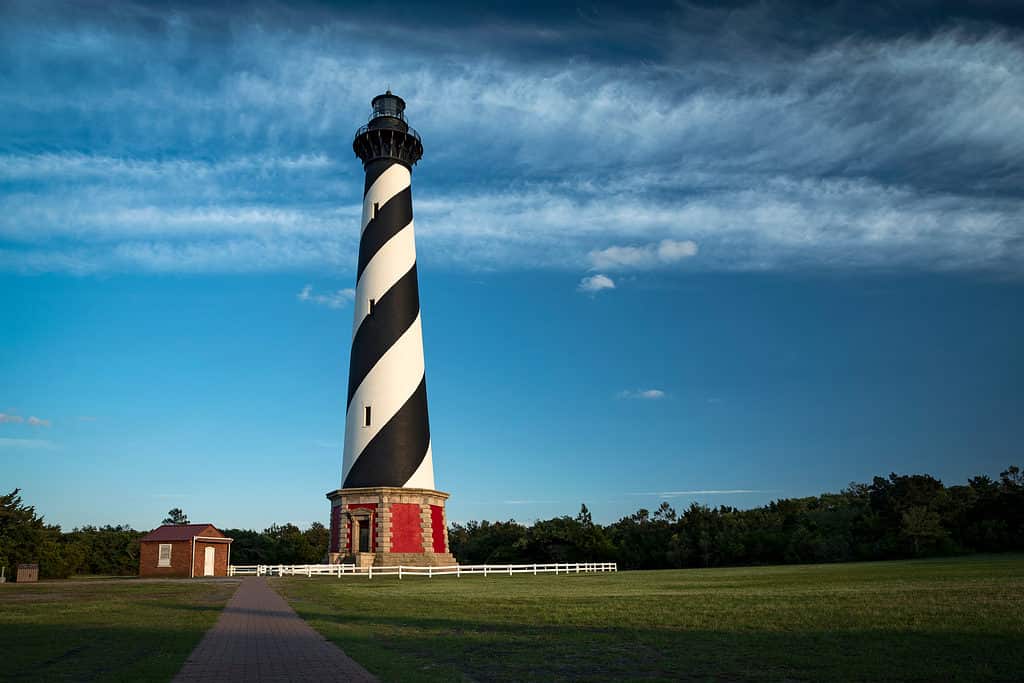
The Cape Hatteras Lighthouse is the world’s tallest brick lighthouse, standing at 208 feet and attracting more than 175,000 tourists annually.
©Terry Costelloe/Shutterstock.com
By 1853 the Lighthouse Board had cleared additional construction that brought the Cape Hatteras Lighthouse to 150 feet tall. A Fresnel lens was also installed to help strengthen the beam, but by the 1860s Congress found the whole structure was in enough need of repair to warrant rebuilding it from the ground up. The overhaul began in October of 1868 and was completed on December 16th, 1870.
In 1935 the Cape Hatteras Lighthouse was decommissioned due to impending erosion, but by 1950 the issue was resolved and it was operating again. The National Park Service assumed control of the premises and the tower came under the operation of the United States Coast Guard.
In the 1990’s erosion concerns again threatened the status of the lighthouse. The Cape Hatteras Island beachfront had seen decades of hurricanes and stormy weather and the decay was fast encroaching upon the tower and lighthouse keeper housing.
On the eve of the new millennium, in a complicated and impressive engineering feat, everything was relocated 2,900 feet inland to a more stable area over a period of 23 days. This set a Guinness world record for the farthest distance a brick lighthouse had ever been moved.
Summary of the 5 Most Beautiful East Coast Lighthouses
| Rank | Name | Height | Date built |
|---|---|---|---|
| 1 | Cape Neddick Lighthouse | 41 feet | July 1st, 1879 |
| 2 | Gay Head Light | 51 feet | 1799 |
| 3 | Montauk Lighthouse | 110 feet | 1796 |
| 4 | Fire Island Lighthouse | 168 feet | Originally built in 1826 Rebuilt in 1857 |
| 5 | Cape Hatteras Lighthouse | 208 feet | Originally built in 1803 Relocated in 2000 |
The photo featured at the top of this post is © iStock.com/Jens_Lambert_Photography
Sources
- Lighthouse Friends, Available here: https://www.lighthousefriends.com/light.asp?ID=548
- Dockside, Available here: https://www.docksidegq.com/blog/cape-neddick-lighthouse/
- US Lighthouses, Available here: https://www.us-lighthouses.com/cape-neddick-lighthouse
- New England Lighthouses and Coastal Attractions, Available here: https://www.nelights.com/exploring/Massachusetts/gay_head_lighthouse.html#gsc.tab=0
- Advisory Council on Historic Preservation, Available here: https://www.achp.gov/success-stories/gay-head-lighthouse
- Discover Long Island, Available here: https://www.discoverlongisland.com/listing/montauk-point-lighthouse-museum/243/
- Fire Island Lighthouse Preservation Society, Available here: https://www.fireislandlighthouse.com/history
- National Park Service, Available here: https://www.nps.gov/fiis/planyourvisit/fireislandlighthouse.htm
- National Park Service, Available here: https://www.nps.gov/caha/planyourvisit/chls.htm
- OuterBanks.com, Available here: https://www.outerbanks.com/cape-hatteras-lighthouse.html
Thank you for reading! Have some feedback for us? Contact the AZ Animals editorial team.






